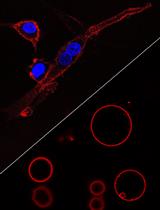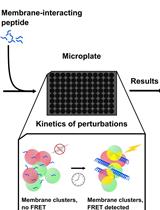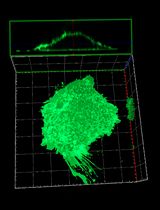- EN - English
- CN - 中文
Calcein Release Assay to Measure Membrane Permeabilization by Recombinant Alpha-Synuclein
钙黄绿素释放法测定重组α-突触核蛋白膜通透性
(*contributed equally to this work) 发布: 2020年07月20日第10卷第14期 DOI: 10.21769/BioProtoc.3690 浏览次数: 7853
评审: David PaulJohn P PhelanAnonymous reviewer(s)
Abstract
Lipid membranes are involved in regulating biochemical and biological processes and in modulating the selective permeability of cells, organelles, and vesicles. Membrane composition, charge, curvature, and fluidity all have concerted effects on cellular signaling and homeostasis. The ability to prepare artificial lipid assemblies that mimic biological membranes has enabled investigators to obtain considerable insight into biomolecule-membrane interactions. Lipid nanoscale assemblies can vary greatly in size and composition and can consist of a single lipid monolayer, a bilayer, or other more complex assemblies. This structural diversity makes liposomes suitable for a wide variety of biochemical and clinical applications. Here, we describe a calcein dye leakage assay that we have developed to monitor phospholipid vesicle disruption by alpha-synuclein (αSyn), a presynaptic protein that plays a central role in Parkinson’s disease (PD). We present data showing the effect of adenylylation of αSyn on αSyn-mediated vesicle disruption as an example. This assay can be used to study the effect of mutations or post-translational modifications on αSyn-membrane interactions, to identify protein binding partners or chemical entities that perturb these interactions, and to study the effects of different lipids on the permeabilization activity of αSyn or any other protein.
Keywords: Alpha-synuclein (α-突触核蛋白)Background
Liposomes are nanoscale lipid assemblies formed as a result of hydrophilic and hydrophobic interactions among lipid head groups and fatty acid side chains, respectively. These biological membrane-mimicking lipid bilayer assemblies are a useful tool for studying membrane interactions of protein biomolecules due to (i) the flexibility of modulating the diameter of the liposomes, and thus the membrane curvature; and (ii) control over the lipid composition (Ahmed et al., 2019; Siontorou et al., 2017). Due to their bilamellar structure, liposomes contain an intralumenal aqueous cavity within which water-soluble reagents can be encapsulated (Duzgunes et al., 2010). This property has been exploited in drug delivery approaches (Alavi et al., 2017) and in studies of membrane permeabilization (Gupta et al., 2013) and vesicle fusion (Duzgunes et al., 2010) involving the encapsulation of fluorescent, hydrophilic (membrane-impermeable) markers.
Alpha-Synuclein (αSyn) is a presynaptic protein that interacts with negatively charged cellular membranes as part of its biological function (Pineda and Burre, 2017). αSyn interactions with membranes are also known to induce aggregation of the protein on the membrane surface (Ysselstein et al., 2015).This process is hypothesized to lead to a disruption of membrane integrity as a result of lipid extraction during the growth of αSyn aggregates on the bilayer (Ysselstein et al., 2017; Reynolds et al., 2011). Evidence suggests that membrane-induced αSyn aggregation coupled with vesicle disruption contributes to αSyn neurotoxicity in PD (Ysselstein et al., 2017).
αSyn-mediated vesicle permeabilization has been modeled using different biophysical methods, including assays designed to monitor the leakage of dyes from synthetic liposomes (Reynolds et al., 2011; Iyer et al., 2019). The water-soluble fluorophore calcein is well suited for dye leakage assays because it undergoes self-quenching at high concentrations in the lumenal space of synthetic vesicles, but shows a dramatic increase in fluorescence emission upon dilution in the extra-liposomal buffer following membrane disruption (Figure 1). We and other labs have used a calcein leakage assay to characterize the vesicle permeabilization activity of wild-type (WT) αSyn and mutant or post-translationally modified forms of the protein (Sanyal et al., 2019), as well as to assess the effect of an αSyn-interacting protein on vesicle disruption (Ysselstein et al., 2017). Here, we describe the calcein leakage assay and present data obtained using this method showing the effect of adenylylation on αSyn-mediated vesicle disruption.

Figure 1. Schematic of calcein leakage assay designed to monitor liposome disruption in the presence of alpha-synuclein. Fluorescence increases over time, and the rate of increase is dependent upon the membrane permeabilization activity of the added alpha-synuclein variant.
Materials and Reagents
- Eppendorf Safe-Lock Tubes (Eppendorf, catalog number: 0 22363204 )
- Solid black 96-well plate (Corning, catalog number: 07-200-336 ) or 384-well plate (Corning, catalog number: 09-761-21 )
- Plastic plate seal (Excel Scientific, catalog number: 100-SEAl-PLT )
- Econo-Pac gravity-flow column (Bio-Rad, catalog number: 732-1010 )
- Polycarbonate membrane (0.05 µm, Avanti Polar Lipids, Inc., catalog number: 610003 )
- Hamilton glass syringe (Avanti Polar Lipids, Inc., catalog number: 610036 )
- Glass vial (Sigma-Aldrich, Millipore Sigma, catalog number: 27023 )
- Glass round-bottom flask (Fisher Scientific, catalog number: 10-060-4A )
- Disposable plastic cuvette
- 0.22 μm membrane
- Egg phosphatidylglycerol (egg PG) (Avanti Polar Lipids, Inc., catalog number: 841138 )
- Egg phosphatidylcholine (egg PC) (95%) (Avanti Polar Lipids, Inc., catalog number: 131601 )
- Calcein (Sigma-Aldrich, Millipore Sigma, catalog number: C0875 )
- Sephadex G-50 Superfine (GE Healthcare, Life Sciences, catalog number: 17004101 or 17004103 )
- Nitrogen gas (Indiana Oxygen, catalog number: 23-150224 )
- NaOH solid (Sigma-Aldrich, Millipore Sigma, catalog number: 221465 )
- HCl solution, 1 N (Fisher Scientific, catalog number: SA48-500 )
- NaCl
- KCl
- Na2HPO4
- KH2PO4
- Chloroform (Sigma-Aldrich, Millipore Sigma, catalog number: C2432 )
- Carbon-coated copper grid (Electron Microscopy Sciences, catalog number: CF400CU )
- Nalgene rapid-flow sterile disposable filter unit (Fisher Scientific, catalog number: 09-740-43B )
- 20% (v/v) ethanol (Fisher Scientific, catalog number: A962S-4 ) in deionized H2O
- 0.02% (w/v) NaN3 (ACROS Organic, catalog number: AC190380050 ) in deionized H2O
- 1% (w/v) Phosphotungstic acid (PTA) (Electron Microscopy Sciences, catalog number: 12501-23-4 ) in deionized H2O
- Bicinchoninic acid protein assay kit (Pierce, catalog number: 23227 )
- 1x PBS solution (prepared from 10x PBS stock, see Recipes)
- 2 N NaOH solution (see Recipes)
Equipment
- Small beaker
- Mini-Extruder (Avanti Polar Lipids, Inc., catalog number: 610020 )
- Filter support (Avanti Polar Lipids, Inc., catalog number: 610014 )
- Desiccator (Fisher Scientific, catalog number: 08-642-7 )
- Fisherbrand Analog Vortex Mixer (Fisher Scientific, catalog number: 02-215-414 )
- TECAN Infinite 200 Pro (TECAN, catalog number: INF-FPLEX )
- OsmoPro Multi-Sample Micro-Osmometer (Fisher Scientific, catalog number: 22-046-680 )
- FEI Tecnai G2 20 transmission electron microscope (Thermo Fisher Scientific; Tecnai)
- Delsa Nano Submicron Particle Size and Zeta Potential Analyzer (Beckmann Coulter, catalog number: A54412AC )
- Chemical fume hood
- -20 °C freezer
Software
- I-controlTM or MagellanTM Standard (used for calcein fluorescence data acquisition)
- Gatan Digital Micrograph (Gatan Microscopy Suite) (used for electron micrograph acquisition)
- DelsaTM Nano UI (used for dynamic light scattering data acquisition)
Procedure
文章信息
版权信息
© 2020 The Authors; exclusive licensee Bio-protocol LLC.
如何引用
Dutta, S., Watson, B. G., Mattoo, S. and Rochet, J. (2020). Calcein Release Assay to Measure Membrane Permeabilization by Recombinant Alpha-Synuclein. Bio-protocol 10(14): e3690. DOI: 10.21769/BioProtoc.3690.
分类
神经科学 > 神经系统疾病 > 细胞机制
生物化学 > 脂质 > 膜脂
您对这篇实验方法有问题吗?
在此处发布您的问题,我们将邀请本文作者来回答。同时,我们会将您的问题发布到Bio-protocol Exchange,以便寻求社区成员的帮助。
提问指南
+ 问题描述
写下详细的问题描述,包括所有有助于他人回答您问题的信息(例如实验过程、条件和相关图像等)。
Share
Bluesky
X
Copy link













